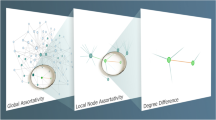Abstract
Many real-world networks such as the protein–protein interaction networks and metabolic networks often display nontrivial correlations between degrees of vertices connected by edges. Here, we analyse the statistical methods used usually to describe the degree correlation in the networks, and analytically give linear relation in the degree correlation. It provides a simple and interesting perspective on the analysis of the degree correlation in networks, which is usefully complementary to the existing methods for degree correlation in networks. Especially, the slope in the linear relation corresponds exactly to the degree correlation coefficient in networks, meaning that it can not only characterize the level of degree correlation in networks, but also reflects the speed that the average nearest neighbours’ degree varies with the vertex degree. Finally, we applied our results to several real-world networks, validating the conclusions of the linear analysis of degree correlation. We hope that the work in this paper can be helpful for further understanding the degree correlation in complex networks.


Similar content being viewed by others
References
S Boccaletti, V Latora, Y Moreno, M Chavez and D U Hwang, Phys. Rep. 424, 175 (2006)
S Mukherjee and N Gupte, Pramana – J. Phys. 70, 1109 (2008)
Q Zhao, X Kong and Z Hou, Pramana – J. Phys. 73, 955 (2009)
L Zemanová, G Zamora-López, C Zhou and J Kurths , Pramana – J. Phys. 70, 1087 (2008)
L Ying and D W Ding, Pramana – J. Phys. 80, 337 (2013)
R Pan and S Sinha, Pramana – J. Phys. 71, 331 (2008)
P Chen and S Redner, J. Inform. 4, 278 (2010)
R Guimera and L A Nunes Amaral, Nature 433, 895 (2005)
S -H Zhang, X -M Ning, C Ding and X -S Zhang, BMC Syst. Biol. 4, 1 (2010)
M E J Newman, Phys. Rev. E 67, 026126 (2003)
M E J Newman, Phys. Rev. Lett. 89, 208701 (2002)
R Pastor-Satorras, A Vázquez and A Vespignani, Phys. Rev. Lett. 87, 258701 (2001)
C Friedel and R Zimmer, BMC Bioinform. 8, 297 (2007)
T Tanizawa, S Havlin and H E Stanley, Phys. Rev. E 85, 046109 (2012)
Q Miao, Z Rong, Y Tang and J Fang, Physica A 387, 6225 (2008)
J -T Sun, S -J Wang, Z -G Huang and Y -H Wang, Physica A 388, 3244 (2009)
C E La Rocca, L A Braunstein and P A Macri, Physica A 390, 2840 (2011)
M Chavez, D U Hwang, J Martinerie and S Boccaletti, Phys. Rev. E 74, 066107 (2006)
A L Pastore y Piontti, L A Braunstein and P A Macri, Phys. Lett. A 374, 4658 (2010)
L D Valdez, C Buono, L A Braunstein and P A Macri, Europhys. Lett. 96, 38001 (2011)
F Sorrentino, M di Bernardo, G H Cuéllar and S Boccaletti, Physica D 224, 123 (2006)
J Menche, A Valleriani and R Lipowsky, Europhys. Lett. 89, 18002 (2010)
J L Payne, P S Dodds and M J Eppstein, Phys. Rev. E 80, 026125 (2009)
M Schläpfer and L Buzna, Phys. Rev. E 85, 015101 (2012)
C W Ma and K Y Szeto, Phys. Rev. E 73, 047101 (2006)
J L Garcia-Domingo, D Juher and J Saldaña, Physica D 237, 640 (2008)
A Pusch, S Weber and M Porto, Phys. Rev. E 77, 017101 (2008)
M Ramos and C Anteneodo, Random degree–degree correlated networks, arXiv:1206.6266v1 (2012)
S Maslov and K Sneppen, Science 296, 910 (2002)
http://www.caac.gov.cn/C1/200807/t20080723_17530.html, in: Civil Aviation Administration of China (CAAC) (2009)
J Wang, H Mo, F Wang and F Jin, J. Transport Geography 19, 712 (2011)
D Bu, Y Zhao, L Cai, H Xue, X Zhu, H Lu, J Zhang, S Sun , L Ling, N Zhang, G Li and R Chen, Nucl. Acid. Res. 31, 2443 (2003)
L A Adamic and N Glance, The political blogosphere and the 2004 U.S. election: Divided they blog, in: Proceedings of the 3rd International Workshop on Link Discovery (ACM, Chicago, Illinois, 2005) pp. 36–43
M E J Newman, Proc. Natl Acad. Sci. USA 98, 404 (2001)
B Vladimir and M Andrej, in: Pajek datasets, http://vlado.fmf.uni-lj.si/pub/ networks/data/
Acknowledgement
The authors are grateful to the reviewer for the comments as well as the suggestion about the KS-test. This work has been supported by the construct program of the key discipline in Hunan Province, the Scientific Research Fund of Education Department of Hunan Province (Grant Nos 14C0126, 11B128, 14C0127, 14C0112, 12C0505 and 14B024), the Project of Changsha Medical University (Grant No. KY201517), the Department of Education of Hunan Province (Grant No. 15A023), the Hunan Provincial Natural Science Foundation of China (Grant No. 2015JJ6010), the Hunan Provincial Natural Science Foundation of China (Grant No. 13JJ4045), the National Natural Science Foundation of China (Grant No. 11404178) and the National Natural Science Foundation of China (Grant No. 81300231), and partly by the Doctor Startup Project of Xiangtan University (Grant No. 10QDZ20).
Author information
Authors and Affiliations
Corresponding authors
Rights and permissions
About this article
Cite this article
XIANG, J., HU, T., ZHANG, Y. et al. Linear analysis of degree correlations in complex networks. Pramana - J Phys 87, 84 (2016). https://doi.org/10.1007/s12043-016-1290-y
Received:
Revised:
Accepted:
Published:
DOI: https://doi.org/10.1007/s12043-016-1290-y




